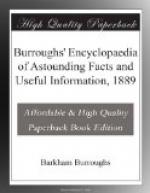862 \
538 /
674 \
843 /
____
2917
Thus, in the above example, we do not say 3 and 4 are 7 and 8 are 15 and 2 are 17, but speak the sum of the couplet, thus 7 and 10 are 17, and in the second column, 12 and 9 are 21. This method of grouping the figures soon becomes easy and reduces the labor of addition about one-half, while those somewhat expert may group three or more figures, still more reducing the time and labor, and sometimes two or more columns may be added at once, by ready reckoners.
Another method is to group into tens when it can be conveniently done, and still another method in adding up long columns is to add from the bottom to the top, and whenever the numbers make even 10, 20, 30, 40 or 50, write with pencil a small figure opposite, 1, 2, 3, 4 or 5, and then proceed to add as units. The sum of these figures thus set out will be the number of tens to be carried to the next column.
6^{2} 2 8
3 5^{2} 4^{1}
2 8 4
9 6 2
7^{2} 1 8^{2}
8 3^{2} 5
5 2 7
1^{1} 3 2^{1}
5 8 8
_________________
5 0 2 8
SHORT METHODS OF MULTIPLICATION.
For certain classes of examples in multiplication short methods may be employed and the labor of calculation reduced, but of course for the great bulk of multiplications no practical abbreviation remains. A person having much multiplying to do should learn the table up to twenty, which can be done without much labor.
To multiply any number by 10, 100, or 1000, simply annex one, two, or three ciphers, as the case may be. If it is desired to multiply by 20, 300, 5000, or a number greater than one with any number of ciphers annexed, multiply first by the number and then annex as many ciphers as the multiplier contains.
TABLE.
5 cents equal 1/20 of a dollar. 10 cents equal 1/10 of a dollar. 12-1/2 cents equal 1/8 of a dollar. 16-2/3 cents equal 1/6 of a dollar. 20 cents equal 1/5 of a dollar. 25 cents equal 1/4 of a dollar. 33-1/3 cents equal 1/3 of a dollar. 50 cents equal 1/2 of a dollar.
Articles of merchandise are often bought and sold by the pound, yard, or gallon, and whenever the price is an equal part of a dollar, as seen in the above table, the whole cost may be easily found by adding two ciphers to the number of pounds or yards and dividing by the equivalent in the table.
Example. What cost 18 dozen eggs at 16-2/3c per dozen?
6)1800 _____ $3.00
Example. What cost 10 pounds butter at 25c per pound?
4)1000 ----- $2.50
Or, if the pounds are equal parts of one hundred and the price is not, then the same result may be obtained by dividing the price by the equivalent of the quantity as seen in the table; thus, in the above case, if the price were 10c and the number of pounds 25, it would be worked just the same.




